NEW YORK, Jan. 21, 2020 /PRNewswire/ -- Elliott Management Corporation ("Elliott"), which manages funds that currently own an economic interest equivalent to 11.3 million shares in Evergy, Inc. (the "Company," or "Evergy"), equating to approximately $760 million in current market value, today released a letter to Evergy's Board outlining steps which should result in high-certainty, line-of-sight equity value creation of up to $5 billion, with opportunities for significant additional value creation over time.
According to the letter, Elliott sees a clear opportunity to achieve this significant increase in shareholder value while providing tangible benefits to all of Evergy's key stakeholders, including customers, employees and the broader communities its utilities serve. The letter asserts that a renewed focus on improving core utility operations and investing in Evergy's critical system infrastructure can rectify its prolonged underperformance, discounted valuation and associated increased cost of capital.
In the letter, Elliott stated that increased system investment would not only provide meaningfully more value to shareholders than the current strategy to repurchase shares, but would also provide clearly superior benefits to Evergy's other stakeholders, help facilitate the Company's deployment of renewables and reduce its carbon footprint. Elliott urged Evergy to immediately explore both of the following alternative paths:
- Standalone Path: Implement High-Performance Plan with Enhanced Oversight – Develop and implement a high-performance plan with the direct input of certain new highly-credentialed Board- and management-level leadership, to increase critical infrastructure investment and optimize operating costs, leading to annual rate-base growth of up to 10% with no expected overall rate impact on customer bills.
- Combination Path: Pursue Strategic Premium Merger Transaction – Explore a strategic combination via a premium stock-for-stock merger, following which Evergy's new partner would oversee the implementation of a high-performance plan, leading to value creation in which Evergy's current shareholders would be able to participate by receiving stock in the combined entity.
Elliott believes either path, if executed properly, should result in high-certainty, line-of-sight equity value creation of up to $5 billion, with opportunities for significant additional value creation over time.
Elliott noted that it sought to engage the Evergy Board on a private basis in October 2019. However, in response to Elliott's outreach, the Board chose not to engage with Elliott on the merits of its suggestions but instead opted to make defensive changes to the Company's governance. Based on this abrupt change, Elliott determined that it would be in the best interest of all stakeholders to make public its views and facilitate a broader discussion of the best path forward for Evergy.
The letter can be downloaded at EnergizeEvergy.com.
The full text of the letter follows:
January 21, 2020
The Board of Directors
Evergy, Inc.
1200 Main Street
Kansas City, Missouri 64105
Dear Members of the Board:
We are writing to you on behalf of Elliott Associates, L.P., Elliott International, L.P. and affiliates (together "Elliott" or "we"). We have followed certain of Evergy's utility companies dating back more than 15 years. Elliott currently owns an economic interest equivalent to 11.3 million shares in Evergy, Inc. (the "Company," or "Evergy"), approximately $760 million in market value.
Over the past three months, we have been engaged in a private dialogue principally with Evergy management on ways to maximize value for all of Evergy's key stakeholders. We appreciate your time and participation in this private dialogue and, while we currently appear to have differing views on the right path forward, we are hopeful that this discussion can continue.
We have made such a large investment in Evergy because we believe a clear opportunity exists to create significant shareholder value. This would lower the Company's cost of capital and provide tangible benefits to all of Evergy's key stakeholders, including customers, employees, regulators and the broader communities its utilities serve. We believe Evergy's valuation does not properly reflect the value of its collection of high-quality regulated utilities in Kansas and Missouri, and that a renewed focus on improving core utility operations and investing in Evergy's critical electric infrastructure can rectify its prolonged underperformance, discounted valuation and associated increased cost of capital.
We believe that Evergy's stock-price underperformance since the completion of the Great Plains / Westar Merger (the "Merger") reflects investors' increasingly skeptical outlook on the Company's long-term plan and its recent strategic decisions. Investors are especially skeptical regarding Evergy's current strategy of using capital to repurchase shares at the expense of increased investment in its infrastructure. As we lay out below, increased system investment would not only provide meaningfully more value to shareholders than buybacks, but would also provide clearly superior benefits to Evergy's customers, employees, regulators and the broader communities Evergy's utilities serve, in addition to helping to facilitate the Company's deployment of renewables and reducing its carbon footprint.
This long-term plan and current operating and strategy decisions have led to bottom-quartile (and in some instances bottom-decile) operating-cost performance, system capital investment, rate-base growth, and cost of capital among U.S. mid- and large-cap regulated utilities. Fortunately, we believe these strategic, operating-plan and capital-allocation issues can be addressed in the near term, allowing Evergy's utilities to become high-performing electricity providers. To put the Company back on a track where it can create sustainable value for all key stakeholders, Evergy should immediately explore both of the following alternative paths:
- Standalone Path: Implement High-Performance Plan with Enhanced Oversight – Develop and implement a high-performance plan with the direct input of certain new highly-credentialed Board- and management-level leadership, to increase critical infrastructure investment and optimize operating costs, leading to annual rate-base growth of up to 10% with no expected overall rate impact on customer bills.
- Combination Path: Pursue Strategic Premium Merger Transaction – Explore a strategic combination via a premium stock-for-stock merger, following which Evergy's new partner would oversee the implementation of a high-performance plan, leading to value creation in which Evergy's current shareholders would be able to participate by receiving stock in the combined entity.
We believe either path, if executed properly, should result in high-certainty, line-of-sight equity value creation of up to $5 billion, with opportunities for significant additional value creation over time. In addition, we believe the business improvements envisioned under either path will leave Evergy better positioned to serve all of its key stakeholders, with stronger corporate governance and a greater commitment to renewable energy.
The purpose of today's letter is to share our thoughts with investors on the opportunities available at Evergy to create shareholder value and provide tangible benefits to its key stakeholders and constituent communities. Given our interactions with management and the Board to date as well as Evergy's persistent share-price underperformance, we believe the time has come for a full public discussion regarding the best path forward for Evergy.
We have organized our thoughts in the following manner:
(i) Elliott's Investment in Evergy;
(ii) Evergy's Collection of High-Quality Regulated Utilities;
(iii) Evergy's Current Plan and Resulting Underperformance;
(iv) Opportunity for Value Creation at Evergy;
(v) High-Performance Paths Forward for Evergy; and
(vi) Next Steps.
Elliott's Investment in Evergy
Elliott is a multi-strategy investment firm that was founded in 1977 and has more than $40 billion in assets under management today. We have a strong track record of investing in the power, utility and energy sectors and working with companies to create long-term stakeholder value.
We first approached management and the Board on a private basis in early October 2019 and hoped to work privately to identify the best path forward for Evergy. However, in response to our outreach, the Board chose not to engage with us on the merits of our suggestions but instead opted to make defensive changes to the Company's governance.
Based on this abrupt change to the Company's governance, limiting the ability of shareholders to nominate and elect directors, as well as a lack of progress toward the exploration of any value-maximizing operational and/or strategic alternatives, we determined that it would be in the best interest of all stakeholders to make our views public and facilitate a broader discussion of the best path forward for Evergy.
Evergy's Collection of High-Quality Regulated Utilities
Evergy is composed of three coveted regulated utilities in constructive regulatory jurisdictions. With the right stakeholder-focused capital plan and an operating strategy centered around enhanced system investment to bolster safety, reliability, customer service, security and renewables, Evergy can become a highly valued utility with a lower cost of capital. This should result in Evergy's rate-base and earnings growth coming at least in-line with other leading regulated electric utilities in nearby states in the Midwest, West, Southwest and Southeast regions of the U.S.
Notable features that distinguish Evergy from certain other utility companies include:
- High-quality regulated utilities: Evergy is a collection of high-quality, 100% regulated utilities across two states – Kansas and Missouri.
- Regulatory certainty with constructive regulatory backdrop: Evergy's current multi-year regulatory agreements in Kansas and Missouri provide an extended period of regulatory and rate certainty.
- Strong core investment growth opportunities: Evergy has the continued opportunity to increase core system capital spending in areas that will lead to hardening, modernization, enhanced safety, reliability, security and customer service performance metrics, all on a rate-friendly basis to customers.
- Strong investment opportunities around renewables: Evergy's advantageous geographic location in the wind corridor of the U.S. should provide ample capital deployment opportunities across its business – in transmission and distribution to facilitate greater renewables penetration, and in generation to transition Evergy's aging coal fleet to renewable energy.
- Strong financial metrics: Evergy has moderate overall financial leverage with no need to issue equity in the near term. However, the Company's use of over $3.5 billion to repurchase shares has already somewhat weakened Evergy's holding company balance sheet and increased leverage by ~1.5x, thereby limiting overall flexibility and ability to maintain a proactive strategic posture.
- No overhangs: Evergy is not exposed to merchant generation, foreign subsidiaries, mega-project construction risk or other unregulated businesses.
Evergy's Current Plan and Resulting Underperformance
Despite its positive base business and broader environmental attributes, Evergy has meaningfully underperformed peers, resulting in a notable undervaluation and associated increased cost of capital. Since the Merger, Evergy's total shareholder return ("TSR") has lagged similarly situated Midwest electric utility peers by 25 percentage points.1 While Evergy was valued at a slight premium to peers on a P/E basis for several months following the Merger, it is now valued at a significant discount.
See "Evergy Underperformance Since Completion of Merger" charts.
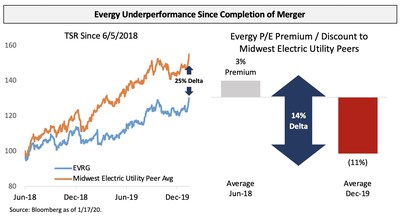
We believe the key reasons for Evergy's underperformance, discounted valuation and associated increased cost of capital can be clearly explained and grouped into two categories:
1) Suboptimal Plan and Strategy: Evergy's current capital plan and operating strategy have led to justifiable concerns around the Company's ability to create long-term value on a standalone basis.
2) Loss of Management and Board Credibility: Operating issues at Great Plains as well as continued operating, accountability and communications issues since the Merger have further eroded investor confidence at Evergy.
Suboptimal Plan and Strategy
Following the Merger, Evergy implemented a unique strategy premised on using cash flow and excess capital to repurchase shares rather than driving sustainable value creation by making critical long-term system investments. Specifically, Evergy's current business plan relies on holding rate base growth to 2-3% for multiple years while relying on share buybacks to manufacture near-term growth in earnings per share.
The math demonstrating why this strategy is suboptimal for Evergy shareholders is simple: Based on average authorized returns on equity, $1 of equity capital invested in rate base for most utilities can earn significantly more than double the return of $1 used to buy back stock. As a result, $1 invested in rate base is worth approximately $2.40 to shareholders, while $1 in share buybacks merely distributes $1 back to shareholders.2
See "Shareholder Value Creation Comparison" charts.
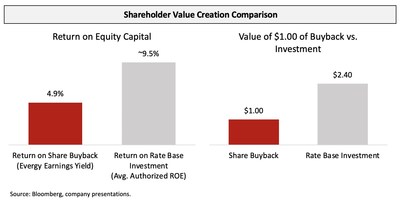
Following completion of the Merger, Evergy's decision to use $3.5 billion of capital to buy back stock instead of using that capital to make system investments will cause utility stakeholders to forego meaningful tangible benefits and translates into approximately $4 billion of shareholder value destruction.
Unsurprisingly, Evergy is an outlier in pursuing this unusual capital-allocation strategy, as other major utilities in the U.S. have sought to invest in critical infrastructure for the benefit of the customers and communities they serve, while minimizing the impact on customer bills by improving efficiency. Indeed, there simply is no recent evidence of value creation in the regulated utility industry from maneuvers such as large-scale levered share-repurchase programs.
Evergy's resulting rate-base growth trajectory is worst-in-class among peers, despite the clear system investment opportunities available to the Company. The map below throws the contrast between Evergy and its peers into stark relief:
See "Rate Base Growth of Nerby Regulated Utilities" map.
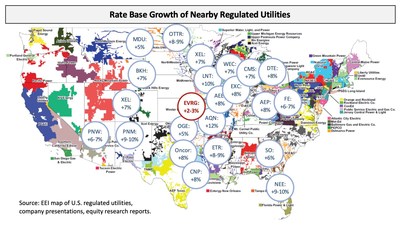
Evergy's low rate base growth and its overreliance on share buybacks have created deep concerns among investors over Evergy's long-term growth outlook and its ability to create value after the share buybacks are completed in mid-2020. These concerns have been highlighted by the equity-research analyst community:
"So these updates put in to question not only the near term earnings profile…but also the L-T growth profile of the company after the financial engineering associated with their share buyback and synergy harvesting from the merger runs its course." – Evercore ISI, 2/24/19
"Longer term, EVRG has regulatory certainty with 4-5 year rate case stay outs in Missouri/Kansas, but there are concerns around earnings power given very modest rate base growth ." – Wolfe, 8/8/19
These research analysts have followed Evergy (and its predecessor companies) for years. Their views are therefore shaped by deep institutional knowledge of Evergy and generally reflect the views of its shareholders.
This lack of confidence in Evergy's current direction is perhaps best illustrated by the fact that Evergy received two separate downgrades by equity research analysts shortly after management presented its business plan at the EEI conference in mid-November 2019.
Loss of Management and Board Credibility
Evergy's performance has been further hampered by consistently subpar execution, representing a continuation of the poor track record of Great Plains prior to the Merger:
- Consistent Under-Earning: During the Evergy senior team's tenure at Great Plains, its utilities failed to consistently earn their authorized ROEs and routinely under-earned by 100-200 basis points. This stands in stark contrast to the vast majority of U.S. regulated utilities, including those in Kansas and Missouri, which have been able to earn their authorized returns on equity. Earning at authorized levels is critical for a utility's ability to achieve access to plentiful, low-cost capital.
- Failed LBO Attempt of Westar: In 2017, Great Plains, a $5 billion market cap company at the time, attempted to acquire Westar at a 36% premium for $8.6 billion in a highly leveraged 85% cash / 15% stock transaction. The transaction was widely criticized by virtually all Great Plains stakeholders, including shareholders, ratepayer advocates and regulators, all of whom expressed grave concerns about the leverage used in the transaction. The Kansas Corporation Commission roundly rejected the transaction, noting that the transaction would leave the new entity with "little financial flexibility and very little margin of error."
Although Great Plains and Westar ultimately consummated a revised, all-stock transaction, Great Plains' aggressive, ill-conceived attempted leveraged buyout of Westar unnecessarily extended the timeline of the transaction and led to heightened regulatory scrutiny.
While investors were hopeful that Evergy would have a fresh start, the record of subpar execution at Great Plains unfortunately has carried over to the combined Company, as evidenced by issues that have emerged since the Merger:
- Negative Guidance Revision: In February 2019, Evergy reported a meaningful earnings miss and lowered rate-base growth guidance from an already meager 3-4% down to 2-3%. This shift in the growth trajectory of the Company only nine months following the completion of the Merger led to widespread investor frustration and further management and Board accountability and credibility issues.
- Regulatory Issues: Continued regulatory issues related to the Sibley coal plant retirement and Jeffrey Energy Center stake acquisition again raised the specter of under-earning, despite regulatory certainty provided by rate stay-outs. Additionally, it appears the Sibley issue was self-inflicted and could have been avoided by fully settling the issue as part of the 2018 rate case.
- Inadequate Carbon Reduction Targets: Evergy's intention of operating its coal plants until the end of their useful lives (2040-2050) is uninspired and economically inefficient. Evergy lags behind leading peers that have pledged to reduce carbon emissions by 70-80% by 2030 and achieve net zero emissions by 2050.
Investors have been keenly aware of Evergy's issues, as evidenced by declining ownership in Evergy by large active stock managers:
See "Evergy Share Ownership By Selected Large Active Managers" chart.
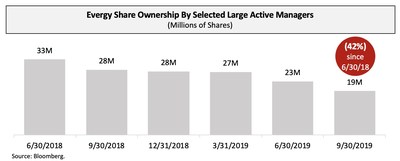
Nor have these issues gone unnoticed by the analysts who follow the Company:
"The management track record here is checkered with regard to delivering consistent financial results—more so on the GXP side of the house than the WR side—and the market reaction to the financial update is in part a function of skepticism that the newly merged companies will have to fight to overcome." – Evercore ISI, 2/24/19
"Entering 2019, we considered EVRG to be a relatively low risk/high visibility play…that narrative changed, however, on the year-end earnings call as management talked down the growth rate through 2021…and laid out lackluster rate base growth of 2-3% through 2023. We were most disappointed by the 2021 guidance revision as that was the first target established for the merger of equals, representing the first critical step to building a track record as EVRG." – Wells Fargo, 3/19/19
The unfortunate result of these missed targets, mishandled regulatory issues and other execution missteps has been a profound loss of investor confidence and an unwillingness on the part of the investment community to invest behind this management team and Board. Current and prospective shareholders see this fact pattern and cannot help but conclude that Evergy's leadership team places little emphasis on providing shareholders with a strong value-proposition to buy and hold Evergy stock. There is a strong case to be made that a combination of changes in direction and oversight are needed to restore investor confidence and remedy the Company's chronic underperformance.
Opportunity for Value Creation at Evergy
We believe robust investment in critical system infrastructure forms the foundation of the investor-owned utility model. U.S. regulated utilities are granted a monopoly franchise with authorized rates of return in order to access abundant low-cost capital to make critical infrastructure investments. The purpose of this model is to benefit customers, create opportunities for employees, and achieve various community objectives, including boosting local economic growth. Evergy's current strategy of limiting system investment and instead using excess capital to repurchase shares is both suboptimal and runs counter to the regulatory compact.
System investment is in fact encouraged by Evergy's regulators. In 2018, the Missouri legislature passed Senate Bill 564 ("SB 564") to encourage additional investment in the state's electrical grid. Missouri Public Service Commission Chairman Ryan Silvey recently commented in a conference call for the investment community: "We expect to see some capital invested in the grid, which was the point of the legislation. So we're hopeful that it results in a lot of upgrades to the grid. That's something that we are in need of." Since the passage of SB 564, both of Missouri's other investor-owned utilities, Ameren and Empire District Electric, have announced the largest capital plans in their respective companies' histories. Ameren expects to grow Missouri rate base at an 8% CAGR, and Empire District Electric expects to grow rate base at a 12% CAGR.
Evergy has significant runway to make much-needed investments in critical electric infrastructure across its system, including in the key areas of safety and reliability, grid hardening and modernization, and physical and cybersecurity infrastructure. Additionally, because of the strength of the wind resource in Evergy's service territory, Evergy stands to be a leader in de-carbonization system investments that facilitate renewables growth and help transition its coal fleet (which still accounts for 40% of its generation capacity) to renewable resources. To frame the opportunity, the U.S. Department of Energy estimates Kansas and Missouri have potential for 785 GW of wind capacity compared to 7 GW installed today.3
Quantifying the Evergy Opportunity
Evergy should reasonably be able to create more than $700 million of high-certainty, line-of-sight, balanced rate headroom, on a standalone basis to support incremental system investment based on:
1) More than $250 million of non-generation operating & maintenance ("O&M") efficiencies;
2) More than $200 million of generation-related fuel and non-fuel O&M savings from replacing only a small portion (~20%) of remaining inefficient coal generation with renewables; and
3) Up to $250 million of rate headroom within the 3% annual limitation imposed by SB 564.
See "Illustrative Evergy Rate Headroom and Usage" chart.
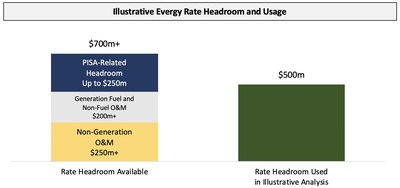
As $1 of rate headroom can be translated into $8-$9 of rate base investment, deploying just $500 million of the above-identified annual rate headroom should result in an additional $4.5 billion of rate base by 2023 compared to Evergy's current plan. Because the bulk of the investment program is funded with ongoing fuel and O&M cost savings rather than rate increases, the overall annualized rate impact to customers is expected to be well below the rate of inflation and likely overall rate neutral.4
Non-Generation O&M Efficiencies: Benchmarking Evergy's non-generation O&M performance against similarly-situated U.S. regulated utilities shows clear evidence that Evergy operates with a bottom-quartile controllable cost structure, with unit costs nearly 50% higher than the median and 80% higher than top-quartile. The fact that Evergy is one of the highest-cost utilities in the U.S. is surprising given that the cost of living in its service territory is below the national average. Improving Evergy's cost structure from bottom-quartile to not even the median would result in incremental savings of more than $350 million and create more than $250 million in additional headroom above and beyond Evergy's anticipated Merger savings.5 We anticipate that these cost savings would be achieved in the next few years.
See "Evergy Unit Non-Generation O&M Comparison" chart.
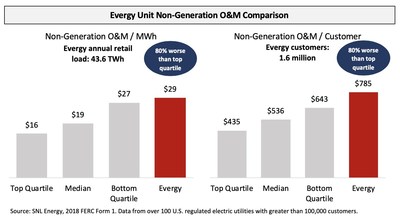
Generation-Related Fuel and Non-Fuel O&M Savings: Transitioning a portion of Evergy's environmentally unfriendly, high-cost coal generation to new renewables generation should yield significant savings in fuel and non-fuel O&M. Illustratively, replacing 5.0 TWh (~20%) of Evergy's highest cost, most inefficient coal generation with wind resources should yield more than $200 million of savings. This transition can also create opportunities for incremental rate base investment into flexible, low-cost storage or capacity to enhance system reliability.
See "Potential Unit Cost Savings From Evergy Coal Replacement" chart.
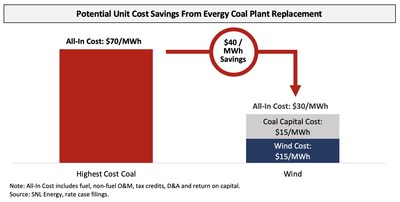
PISA Legislation: Missouri SB 564 enables the implementation of plant-in-service accounting ("PISA"), allowing for more timely recording of earnings associated with capex investments. Under the PISA election, Evergy would be subject to a 3% annualized cap on rate increases from 2018 to 2023. We believe Evergy has up to $250 million of rate headroom under the cap that can be used for investment.
As discussed earlier, this high-performance plan can be implemented either by Evergy on a standalone basis with enhanced oversight or by a strategic transaction partner. Either option would result in significant value creation above and beyond Evergy's current plan.
See "Evergy Value Upside From New High-Performance Plan" table.
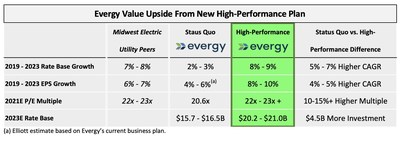
The analysis reflected above does not take into account key upside factors that could create meaningful additional efficiencies to facilitate even more investment and/or reduce customer rates:
- Additional technology-enabled savings created directly by capital investments, as other utilities have experienced;
- Additional non-generation O&M savings from achieving actual median, top-quartile or top-decile cost performance;
- Substantial additional generation fuel and non-fuel O&M-related savings over time from retiring additional coal-plant capacity and replacing with renewables on an accelerated basis; and
- Non-generation O&M, generation fuel and non-fuel O&M, corporate G&A and cost-of-capital synergies from a strategic merger transaction.
Growing Rate Base While Limiting Impact on Customer Bills is a Well-Established Strategy
The "capex for opex" strategy is not novel. The best-run regulated utilities in the U.S. have long used this best-in-class strategy to drive robust rate-base growth with limited-to-no rate impacts on customer bills. For these companies, system investment and operational focus have led to improved safety and reliability, lowered costs of capital, increased service offerings for customers, stronger local economic growth, and climate leadership. For shareholders, this has translated into above-average rate-base growth, above-average earnings-per-share growth and significant long-term total return outperformance. Some examples of high-performance U.S. utilities are:
- NextEra Energy (FPL): NextEra's Florida Power & Light utility ("FPL") subsidiary has been able to grow rate base at a 10% CAGR from 2008 to 2018 while reducing customer bills by 6% and obtaining industry-leading metrics for reliability and carbon emissions. FPL anticipates continuing to grow rate base at a 9% CAGR from 2018-22 while further reducing customer bills.
- NextEra Energy (Gulf Power): Following its acquisition by NextEra in 2019, Gulf Power expects to grow rate base at a 16% CAGR over three years while reducing customer bills by 9% in real terms, improving service reliability by 20% and reducing carbon emissions by 40%.
- WEC Energy Group: From 2015 to 2019, WEC was able to grow rate base in Wisconsin at a 7-8% CAGR despite a four-year base-rate freeze following its acquisition of Integrys.
- Xcel Energy: Through its "Steel for Fuel" program and disciplined O&M cost management, Xcel was able to keep customer bills flat from 2013 to 2018 while continuing robust capital investment in its system.
- CMS Energy: From 2013 to 2019, CMS was able to keep residential bills flat to down (on a weather-normalized basis) while growing total rate base at a 7%+ CAGR.
See "Utility Rate Base Growth Comparison" chart.
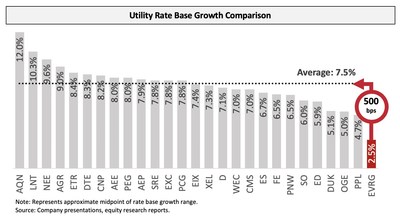
High-Performance Paths Forward for Evergy
We believe a full revamp of Evergy's long-term capital plan and operating strategy is necessary to address underperformance and unlock full value for the benefit of all key stakeholders. This can be accomplished either (i) on a standalone basis with the adoption of an improved capital plan and operating strategy in conjunction with enhanced Board- and management-level oversight, or (ii) via a premium stock-for-stock merger transaction where a tried-and-true strategic partner would accomplish the same. Both paths are superior to the status quo plan and either should allow Evergy to cross the chasm from low-performance / low-value to high-performance / high-value, creating meaningful shareholder value. These paths should be explored now, transparently and in parallel:
See "The Performance / Value Matrix" chart.
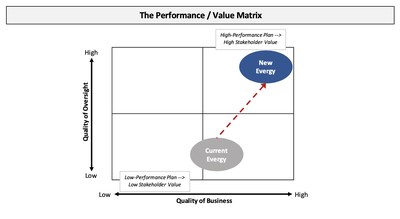
Standalone Path: Implement High-Performance Plan with Enhanced Oversight
- Evergy should reasonably be able to create more than $700 million in high-certainty, line-of-sight, balanced rate headroom to facilitate more than $4.5 billion in potential increased system capital investment. This would accelerate rate-base growth to up to 10% per year with no expected overall rate impact on customer bills.
- Implementation of such a high-performance plan would require enhanced Board oversight through the addition of highly qualified directors with fresh perspectives and deep utility operating experience. Of Evergy's current 15-member Board, outside of the Chairman and CEO, only three possess any relevant utility industry expertise.
- Likewise, given Evergy's record to date, management should include highly experienced utility executives, credentialed in and capable of executing a high-performance plan.
- To facilitate the formulation and implementation of a high-performance plan, Elliott has identified (i) highly qualified independent Board member candidates with deep industry, regulatory, energy policy, renewable energy and leadership experience; and (ii) former senior utility managers that have successfully developed, implemented and overseen high-performance plans at leading U.S. utilities.
Combination Path: Pursue Strategic Premium Merger Transaction
- Evergy's core regulated utility franchises are some of the most pristine electric systems in the U.S. as evidenced by supportive regulatory environments and strong growth potential. We believe that both mid- / large-cap utilities from nearby states and large- / mega-cap diversified utility holding companies, several of whom have seen a meaningful re-rating in their own share prices, would have a keen interest in transacting with Evergy and working to create value for all of Evergy's key stakeholders.
- True scarcity value exists in the mid- / large-cap regulated utility industry in the U.S., which should accrue to the benefit of Evergy. Evergy's Chairman Mark Ruelle noted this when discussing the strategic rationale for utility mergers during regulatory proceedings, stating "we have gone from more than 100 electric utilities in the country to 50 in just a couple of decades."6
- There is a demonstrated record of strong, clear interest in Westar (which accounts for more than 50% of Evergy) from the prior M&A process, in which six bidders (in addition to Great Plains) offered substantial premiums for Westar.
- A transaction with the right strategic partner and with the right stock / cash mix would be well-positioned to obtain regulatory approvals in Kansas and Missouri. Any transaction partner would likely use predominantly stock consideration in a merger with Evergy, avoiding the failed leveraged buyout strategy that doomed the original Great Plains transaction.
- A strategic transaction would eliminate Evergy's valuation discount, lower its cost of capital on an accelerated timeframe, capture merger premium and allow shareholders to retain strong upside potential from mainly stock consideration while locking in high utility-sector valuations (consistent with the continued low point in interest rate cycle) from potential partial cash consideration.
- Importantly, we believe a strategic transaction provides clear benefits to all key stakeholders:
- Customers / Ratepayers: Synergy cost savings; lower overall cost of capital; better technologies for customers / more customer offerings; sharing of best practices.
- Employees: Increased opportunities through increased system investment.
- Regulators / Legislators / Local Communities: Increased system investment providing safer, more reliable and cost-efficient service critical for local economic growth; maintenance of local leadership presence and current headquarters; facilitation of accelerated and more aggressive carbon-reduction targets.
- Investors: Certain, premium value; future upside potential; increased geographic / regulatory diversification; mitigation of potential operational risk.
- Interestingly, in the prior Merger-related regulatory proceedings, Tony Somma's testimony revealed:
Guggenheim Securities, the financial advisor to Westar, conducted an analysis related to the benefits of increased size and scale from the perspective of regulated utilities and their customers… [and] found the following correlations with increased size and scale: 1) higher earned returns for larger utility holding companies; 2) lower non-fuel O&M costs as a percentage of property, plant and equipment balances for larger utility holding companies; and 3) lower effective borrowing costs for larger utility holding companies.7
We believe the same logic would apply today were Evergy to engage in the right strategic combination.
Next Steps
We believe Evergy is at a critical juncture in its history, as more than 19 months have elapsed since the completion of the Merger. Evergy must now determine the best path forward to create sustainable value for all key stakeholders.
Elliott strongly believes that renewed focus on critical system investment is clearly the best strategy and creates tangible benefits for all key stakeholders. As we outlined in this letter, a high-performance path can be achieved either on a standalone basis with enhanced Board oversight and management expertise or through a transaction with a respected strategic partner.
Elliott looks forward to engaging with other Evergy shareholders and stakeholders regarding our ideas, and we are committed to a transparent process to keep all key stakeholders fully informed.
We thank the Board for considering our thoughts and look forward to continuing our discussions to unlock Evergy's full potential. We hope to work constructively with you on the changes needed at Evergy – the changes all key stakeholders deserve.
Sincerely,
Jeff Rosenbaum
Senior Portfolio Manager
About Elliott
Elliott Management Corporation manages approximately $40.2 billion of assets. Its flagship fund, Elliott Associates, L.P., was founded in 1977, making it one of the oldest funds under continuous management. The Elliott funds' investors include pension plans, sovereign wealth funds, endowments, foundations, funds-of-funds, high net worth individuals and families, and employees of the firm.
1 Midwest electric utility peers: XEL, WEC, AEE, CMS, LNT.
2 $1.00 of equity investment can be levered against $1.00 of debt to create $2.00 of rate base, which would be valued at approximately $3.40 in the market (1.7x rate base). The market value of the equity investment would be approximately $2.40 ($3.40 less $1.00 of debt).
3 Source: https://windexchange.energy.gov.
4 Overall annualized rate increase on average across Evergy's service territory.
5 Evergy is targeting $100 million of incremental non-generation Merger savings from 2018-2023.
6 Source: Direct Testimony of Mark Ruelle in 16-KCPE-593-ACQ from June 2016.
7 Source: Direct Testimony of Anthony Somma in EM-2018-0012 from August 2017.
![]() View original content to download multimedia:http://www.prnewswire.com/news-releases/elliott-management-sends-letter-to-board-of-directors-of-evergy-inc-300990314.html
View original content to download multimedia:http://www.prnewswire.com/news-releases/elliott-management-sends-letter-to-board-of-directors-of-evergy-inc-300990314.html
SOURCE Elliott Management Corporation



























